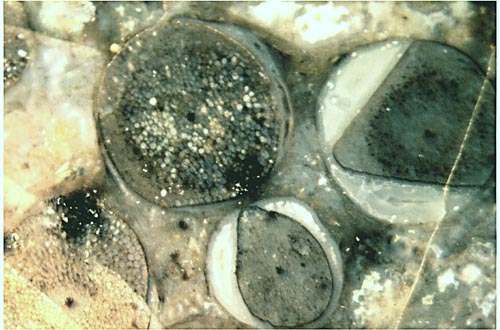Rhynia sections indicating steps of
silicification in Rhynie chert
Straight lines seen on chert faces hint at interesting phenomena.
Usually they mark the horizontal direction during silicification, as in
agates where they are known as onyx or Uruguay bands.
The straight
lines on the peculiar-shaped Rhynia
sections pictured below defy such
interpretation. It appears that they can reveal something about the
silicification
process.

Rhynia
cross-sections with peculiar shapes providing clues concerning details
of the silicification process. Width of the picture 4mm.
The terrestrial vegetation growing near hot springs in the Lower
Devonian landscape at Rhynie was occasionally inundated by sudden
flooding [1]. The silica-rich water eventually became super-saturated
and turned into gel. In the case considered here, this occurred when
the Rhynia
stems were still upright and perfectly round, with the
epidermis still intact as it served as an efficient diffusion barrier
for silica. This can be concluded from the fact that they were not yet
silicified when the surrounding water was. (Walls of dead cells can be
permeable even to larger silica clusters. See
Rhynie Chert News 27.) Subsequently the stems
underwent some process of differential decay
with softening and shrinkage of the interior while the more persistent
epidermis retained some of its mechanical strength.
From a mechanical point of view, the cross-section with the most
uncommon aspect suggests the easiest explanation: Apparently
the tissue except epidermis was in such a state of
decay that it did not offer any resistance to deformation and behaved
rather as a fluid.
Let us consider the succession of steps from circular shape to the
peculiar shape on the right: Tensile stress due
to shrinkage built up along
the epidermis while it stuck to the surrounding
silica gel. This circumferential tensile stress combined with the
curvature implies
the presence of radial tensile stress at the interface between
epidermis and gel. (From the balance of forces follows that the
radial tensile stress is proportional to the ratio of epidermis
thickness and radius of curvature.) The stress
eventually caused the
epidermis to detach from the gel at a mechanically weak spot at the
interface.
Once a small area has been detached, it extends by peeling off, a
process governed by the peel strength.
The epidermis did not easily peel off but reluctantly
separated from the surrounding gel, pulling itself straight. One
might expect some resistance of the interior against this
pulling-straight but there is none here since there is no strength left
and
no volume balance as the water can slowly move across the epidermis and
possibly also escape elsewhere along the shoot. The epidermis had
become detached at two spots. The detached areas got larger until they
met, whereupon the tensile stress relaxed while the
edge was rounded off.
For reasons unknown, the shrinking Rhynia
seen in the section
below detached more readily from the surrounding gel, and for the one
above, silicification was faster than decay so that it became well
preserved.
All the while, the emerging cavities kept filled with water entering by
diffusion, which can be concluded from the fact that no traces of air
bubbles are seen here. Because of the big size
of hydrated silica molecules compared
to water molecules, the diffusion of dissolved
silica through the surrounding silica gel into the water-filled
cavities was so slow that fungus hyphae could thrive there while the
silica concentration was low. (One hypha is vaguely seen in the upper
cavity, ending at a white spot.) When the silica concentration in the
cavities had become sufficiently high, a thin layer of gel made a
lining along the cavity walls and a coating around the fungus hyphae.
The epidermis gradually lost its diffusion barrier effect so that
silica entered into the tissue and preserved it at a certain stage of
decay. With ever more silica arriving via diffusion, the remaining
water pockets became jellyfied, and the water-rich gel gradually became
more solid and finally turned into chert. The slight kink which the
long crack on the right got when running through the former cavity
possibly
indicates that solidification was not yet complete there.
It must be mentioned that usually the plants and organic debris become
silicified first while the surrounding water or mineral mud remain
fluid for
some time. This is due to the fact that the slightly acidic decay
products of organic matter favour the deposition of silica. Samples
with evidence for a reversed sequence of
silicification as in the present case indicate super-saturation of the
silica-rich water which turned into gel before the silica could enter
into the plants.
Silicification of the plants is delayed if they stay alive after
partial flooding. Possibly this has been the case with the sample
considered here, where several hundred Rhynia stems are
there in upright position. The upper parts of most of them are not
contained in the chert layer. Apparently they were above the water
level of the shallow pool. This could have enabled the whole plants to
stay alive after flooding for some time and keep the silica out.
Finally it is emphasized that the wealth of conclusions drawn from the
one picture shown above are meant to
be not merely speculative but rather soundly substantiated.
H.-J. Weiss
2008, improved 2012
[1]
N.H. Trewin : The Rhynie cherts: an early
Devonian
ecosystem preserved by hydrothermal activity.
Scott. J. Geol. 28(1992), 37-47.
 |
 |
31 |




